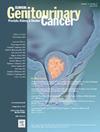Off-Label Use of First-Line Immunotherapy for Metastatic Renal Cell Carcinoma
IF 2.7
3区 医学
Q3 ONCOLOGY
引用次数: 0
Abstract
Introduction
Immune checkpoint inhibitors (ICI) were approved by the Food and Drug Administration (FDA) for patients with metastatic renal cell carcinoma (mRCC) in the second- line setting in 2015 and the first-line (1L) in 2018. Little is known about 1 L ICI use in the off-label (before FDA indication-specific approval) and postapproval settings.
Patients and Methods
We retrospectively analyzed off-label and post-FDA-approval 1 L ICI receipt in a cohort of Medicare beneficiaries ≥66 years old diagnosed with mRCC from 2015 to 2019. Off-label and postapproval 1 L ICI were defined as before or on/after 4/16/2018 (1L ipilimumab/nivolumab approval). Associations between demographic characteristics and 1 L ICI receipt in the off-label and postapproval periods were examined using multivariable logistic regression.
Results
We identified 23,469 patients, of which 368 (2.4%) off-label and 1,663 (21%) postapproval received 1 L ICI. In the off-label period, patients with co-morbid conditions were more likely to receive 1 L ICI compared to patients with no co-morbidities (3+ conditions, OR = 2.00; 95% CL, 1.31-3.05). In the postapproval period, older patients were less likely to receive 1 L ICI (81+ vs. 66-70, OR = 0.60; 95% CL, 0.52-0.69), and patients who were frail were less likely to receive 1 L ICI (OR = 0.77; 95% CL, 0.69-0.87). There were not significant differences in 1 L ICI receipt based on race/ethnicity.
Conclusion
Older patients and patients with more comorbidities were more likely to receive 1 L ICI off-label, but these differences did not persist after FDA approval. After 1 L ipilimumab/nivolumab approval, patients receiving 1 L ICI were more likely younger, healthy, and receiving dual-ICI regimens.
转移性肾细胞癌的非核准使用一线免疫治疗
免疫检查点抑制剂(ICI)于2015年被美国食品和药物管理局(FDA)批准用于转移性肾细胞癌(mRCC)患者的二线治疗,2018年被批准用于一线治疗(1L)。对于1l ICI在标签外(在FDA特定适应症批准之前)和批准后的使用情况知之甚少。患者和方法我们回顾性分析了2015年至2019年诊断为mRCC的≥66岁医疗保险受益人队列中标签外和fda批准后的1l ICI收据。标签外和批准后1L ICI被定义为2018年4月16日之前或之后(1L ipilimumab/nivolumab批准)。使用多变量逻辑回归检查了人口统计学特征与核准后和核准后1 L ICI收据之间的关系。结果我们共发现23469例患者,其中368例(2.4%)为适应症外患者,1663例(21%)为批准后患者接受了1 L ICI。在非适应症期,与无合并症的患者相比,有合并症的患者更有可能接受1 L ICI(3+条件,OR = 2.00;95% cl, 1.31-3.05)。在批准后阶段,老年患者接受1 L ICI的可能性较低(81+ vs. 66-70, OR = 0.60;95% CL, 0.52-0.69),体弱的患者接受1 L ICI的可能性较小(OR = 0.77;95% cl, 0.69-0.87)。基于种族/民族的1 L ICI接收没有显著差异。结论老年患者和合并症较多的患者更容易接受1 L ICI超说明书用药,但在FDA批准后这种差异并未持续存在。ipilimumab/nivolumab批准1l后,接受1l ICI的患者更可能是年轻、健康且接受双ICI方案。
本文章由计算机程序翻译,如有差异,请以英文原文为准。
求助全文
约1分钟内获得全文
求助全文
来源期刊

Clinical genitourinary cancer
医学-泌尿学与肾脏学
CiteScore
5.20
自引率
6.20%
发文量
201
审稿时长
54 days
期刊介绍:
Clinical Genitourinary Cancer is a peer-reviewed journal that publishes original articles describing various aspects of clinical and translational research in genitourinary cancers. Clinical Genitourinary Cancer is devoted to articles on detection, diagnosis, prevention, and treatment of genitourinary cancers. The main emphasis is on recent scientific developments in all areas related to genitourinary malignancies. Specific areas of interest include clinical research and mechanistic approaches; drug sensitivity and resistance; gene and antisense therapy; pathology, markers, and prognostic indicators; chemoprevention strategies; multimodality therapy; and integration of various approaches.
 求助内容:
求助内容: 应助结果提醒方式:
应助结果提醒方式:


